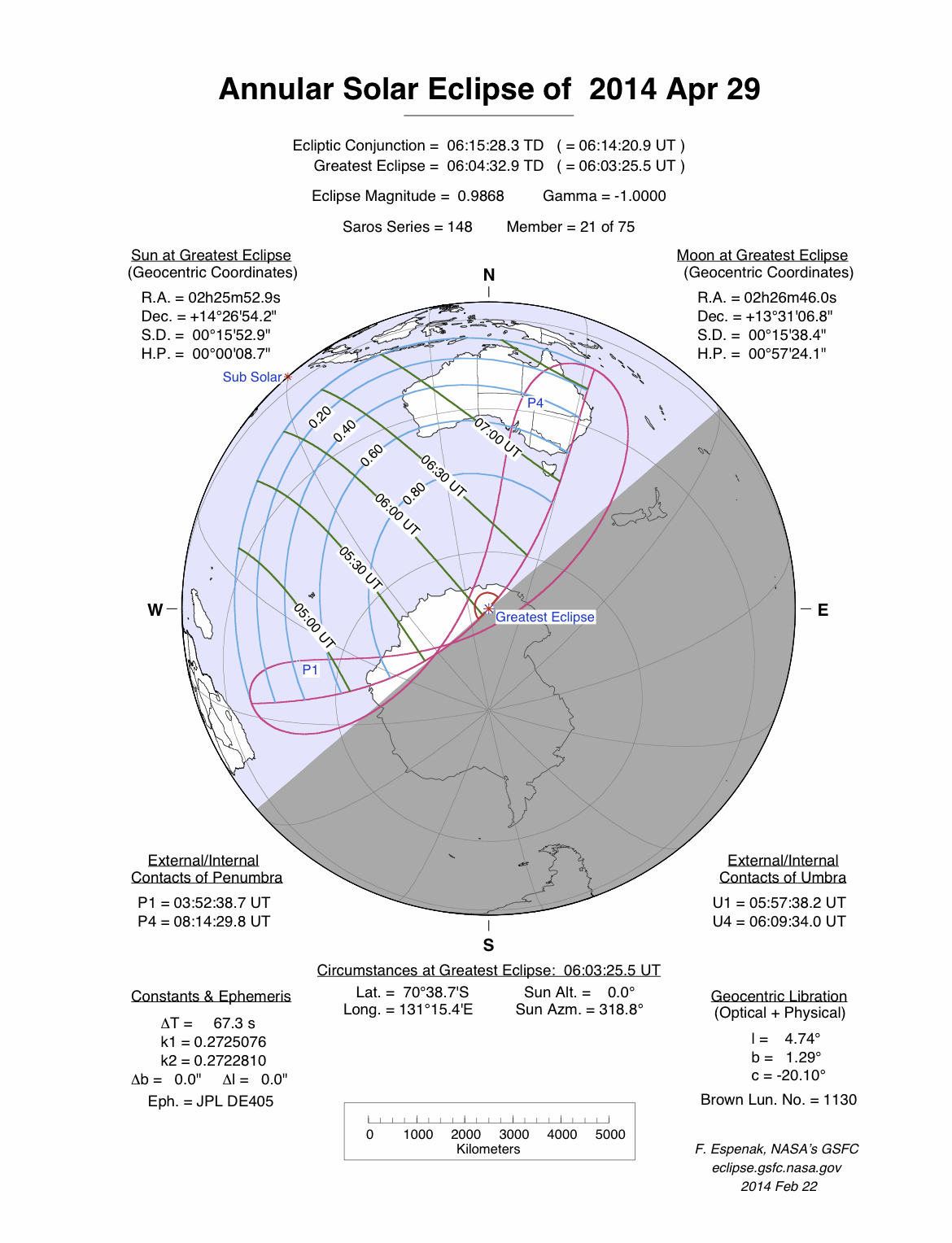An annular eclipse of the Sun occurred on Tuesday 29 April, 2014 UT, lasting from 03:52–08:14 UT. A large annular eclipse covered 99% of the Sun, creating a dramatic spectacle for observers in only an extremely narrow strip; however, it was fleeting, lasting just moments at the point of maximum eclipse. It was seen only from a tiny area in Antarctica. The partial eclipse was visible over most of Australia.
The timings of the phases of the overall eclipse
worldwide are as follows. In any particular
place it would have been seen for a significantly shorter
duration as the shadow moved across the Earth:
| Partial eclipse began: |
03:52:39 UT |
| Annular eclipse began: |
05:57:38 UT |
| Maximum eclipse: |
06:03:25 UT |
| Annular eclipse ended: |
06:09:34 UT |
| Partial eclipse ended: |
08:14:30 UT |
During this eclipse the Sun was 0.529° in apparent
diameter, 0.7% smaller than average. The Moon was 6 days after perigee and 7 days before apogee.
At maximum eclipse it was 0.521° in
apparent diameter, which is 1.9% smaller than average; this was not
large enough to cover the Sun, which is why this
was an annular eclipse.
The statistics page has information on the ranges of the sizes of
the Sun and Moon, and the Moon data page displays detailed
information on the Moon's key dates.
Overview Map
This map sourced from NASA Goddard Space flight Center: GSFC Eclipse Web SiteGSFC Eclipse Web Site
The primary source of all the information on eclipses presented here at Hermit Eclipse. (NASA Goddard Space flight Center)
shows the visibility of the annular solar eclipse. It also shows the broader area in which a partial eclipse was seen. (Click on it for the
full-sized version.)
Eclipse Season and Saros Series
This eclipse season contains 2 eclipses:
This was the 21st eclipse in solar Saros series 148.The surrounding eclipses in this Saros series are:
This Saros series, solar Saros series 148,
is linked to lunar Saros series 141. The
nearest partner eclipses in that series are:
Eclipse Parameters
| UT Date/time (max) | 06:03:24 on 29 Apr UT |
TDT Date/time (max) | 06:04:33 on 29 Apr TDT |
| Saros Series | 148 |
Number in Series | 21 |
| Penumbral Magnitiude | |
Central Magnitiude | 0.9868 |
| Gamma | -1 |
Path Width (km) | 0 |
| Delta T | 1m09s |
Error | ± 0m02s (95%) |
| Penumbral Duration | |
Partial Duration | |
| Total Duration | |
| |
| Partial Rating | |
Total Rating | |
| Sun Distance | 150649606 km (73.5%) |
Moon Distance | 382001 km (50.9%) |
| Sun Diameter | 0.529° |
Moon Diameter | 0.521° - 0.521° |
| Perigee | 00:28 on 23 Apr UT |
Apogee | 10:22 on 6 May UT |
| Contact p1 | 03:52:39 on 29 Apr UT |
Contact p2 | |
| Contact u1 | 05:57:38 on 29 Apr UT |
Contact u2 | |
| Max eclipse | 06:03:25 on 29 Apr UT |
| Contact u3 | |
Contact u4 | 06:09:34 on 29 Apr UT |
| Contact p3 | |
Contact p4 | 08:14:30 on 29 Apr UT |
Note that while all dates and times on this site (except
where noted) are in UT, which is within a second of civil time,
the dates and times shown in NASA's eclipse listingsGSFC Eclipse Web Site
The primary source of all the information on eclipses presented here at Hermit Eclipse. (NASA Goddard Space flight Center)
are in the TDT timescale.
The Sun and Moon distances are shown in km, and as a
percentage of their minimum - maximum distances; hence 0%
is the closest possible (Earth's perihelion, or the
Moon's closest possible perigee) and 100% is
the farthest (aphelion, the farthest apogee).
The statistics page has information on the ranges of sizes
of the Sun and Moon, and the Moon data page displays detailed
information on the Moon's key dates.
Data last updated: 2015-06-21 22:11:46 UTC.

